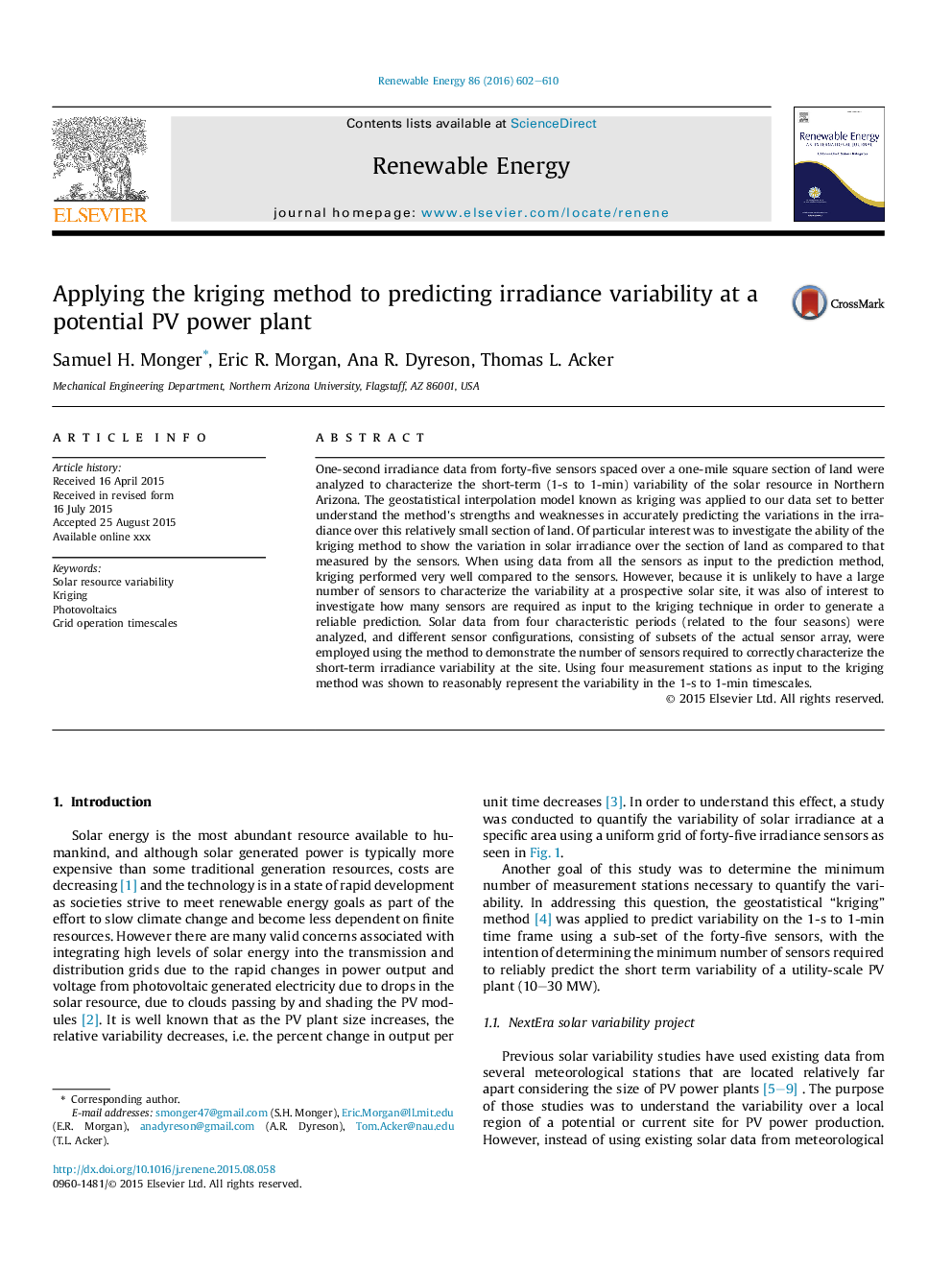| کد مقاله | کد نشریه | سال انتشار | مقاله انگلیسی | نسخه تمام متن |
|---|---|---|---|---|
| 6766607 | 512451 | 2016 | 9 صفحه PDF | دانلود رایگان |
عنوان انگلیسی مقاله ISI
Applying the kriging method to predicting irradiance variability at a potential PV power plant
ترجمه فارسی عنوان
استفاده از روش کریگینگ برای پیش بینی تغییرات تابش در نیروگاه برق پتانسیل بالقوه
دانلود مقاله + سفارش ترجمه
دانلود مقاله ISI انگلیسی
رایگان برای ایرانیان
کلمات کلیدی
تنوع منابع خورشیدی، کریگینگ، فتوولتائیک، زمانبندی عملیات شبکه،
ترجمه چکیده
دادههای خورشیدی یکسوم از چهل و پنج سنسور که در فاصله یک مایل مربع از زمین قرار داشتند، برای مشخص نمودن تغییرات کوتاه مدت (1 تا 1 دقیقه) تغییرات خورشیدی در شمال آریزونا مورد تجزیه و تحلیل قرار گرفت. مدل درون یابی ژئواستاتسیتی به نام کریگینگ برای تعیین داده های ما به منظور درک بهتر نقاط قوت و ضعف این روش در پیش بینی دقیق تغییرات تابش در این بخش نسبتا کوچک زمین مورد استفاده قرار گرفت. علاقه خاصی به بررسی توانایی روش کریگینگ برای نشان دادن تغییرات تابش خورشید در بخش زمین نسبت به اندازه گیری حسگرها بود. هنگام استفاده از داده ها از تمام سنسور ها به عنوان ورودی به روش پیش بینی، کریگینگ نسبت به سنسور بسیار خوب عمل می کند. با این حال، به دلیل اینکه بعضی از سنسورها برای مشخص کردن تغییرات در یک سایت خورشیدی آینده نگر نیستند، بعلاوه نیز برای تشخیص اینکه چند سنسور به عنوان ورودی به تکنیک کریجینگ مورد نیاز است، به منظور ایجاد یک پیش بینی قابل اعتماد، مورد توجه قرار گیرد. داده های خورشیدی از چهار دوره مشخصه (مربوط به چهار فصل) مورد تجزیه و تحلیل قرار گرفته و تنظیمات سنسورهای مختلف شامل متشکل از زیر مجموعه ای از آرایه سنسور واقعی با استفاده از روش برای نشان دادن تعداد سنسورهای مورد نیاز برای درستی مشخص نمودن تابش کوتاه مدت تنوع در سایت. با استفاده از چهار ایستگاه اندازه گیری به عنوان ورودی به روش کریگینگ نشان داده شده است که به طور منطقی نشان دهنده تنوع در زمان بندی های 1 تا 1 دقیقه است.
موضوعات مرتبط
مهندسی و علوم پایه
مهندسی انرژی
انرژی های تجدید پذیر، توسعه پایدار و محیط زیست
چکیده انگلیسی
One-second irradiance data from forty-five sensors spaced over a one-mile square section of land were analyzed to characterize the short-term (1-s to 1-min) variability of the solar resource in Northern Arizona. The geostatistical interpolation model known as kriging was applied to our data set to better understand the method's strengths and weaknesses in accurately predicting the variations in the irradiance over this relatively small section of land. Of particular interest was to investigate the ability of the kriging method to show the variation in solar irradiance over the section of land as compared to that measured by the sensors. When using data from all the sensors as input to the prediction method, kriging performed very well compared to the sensors. However, because it is unlikely to have a large number of sensors to characterize the variability at a prospective solar site, it was also of interest to investigate how many sensors are required as input to the kriging technique in order to generate a reliable prediction. Solar data from four characteristic periods (related to the four seasons) were analyzed, and different sensor configurations, consisting of subsets of the actual sensor array, were employed using the method to demonstrate the number of sensors required to correctly characterize the short-term irradiance variability at the site. Using four measurement stations as input to the kriging method was shown to reasonably represent the variability in the 1-s to 1-min timescales.
ناشر
Database: Elsevier - ScienceDirect (ساینس دایرکت)
Journal: Renewable Energy - Volume 86, February 2016, Pages 602-610
Journal: Renewable Energy - Volume 86, February 2016, Pages 602-610
نویسندگان
Samuel H. Monger, Eric R. Morgan, Ana R. Dyreson, Thomas L. Acker,
